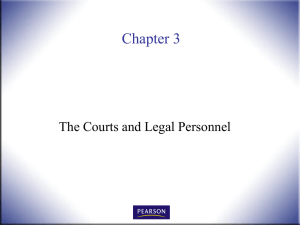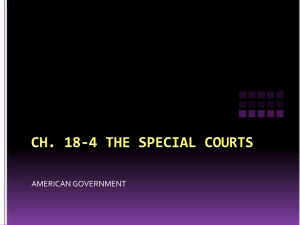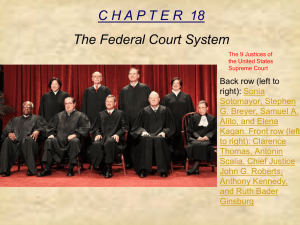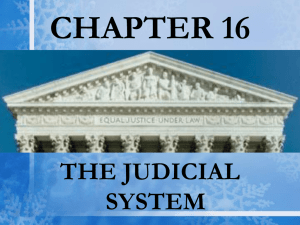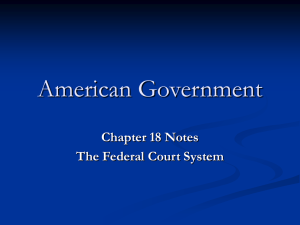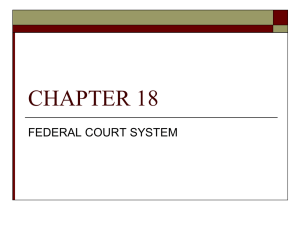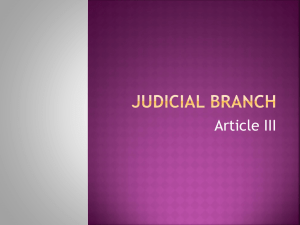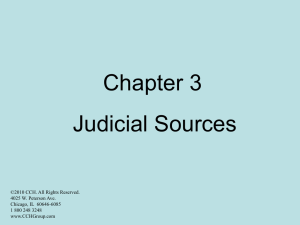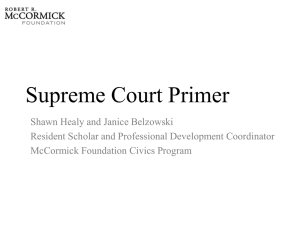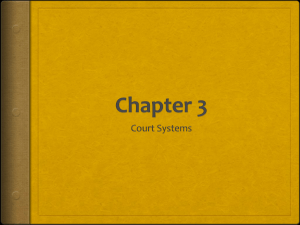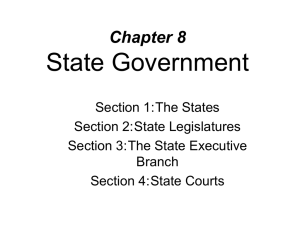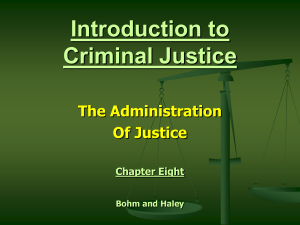Chapter 11: The Federal Court System
advertisement
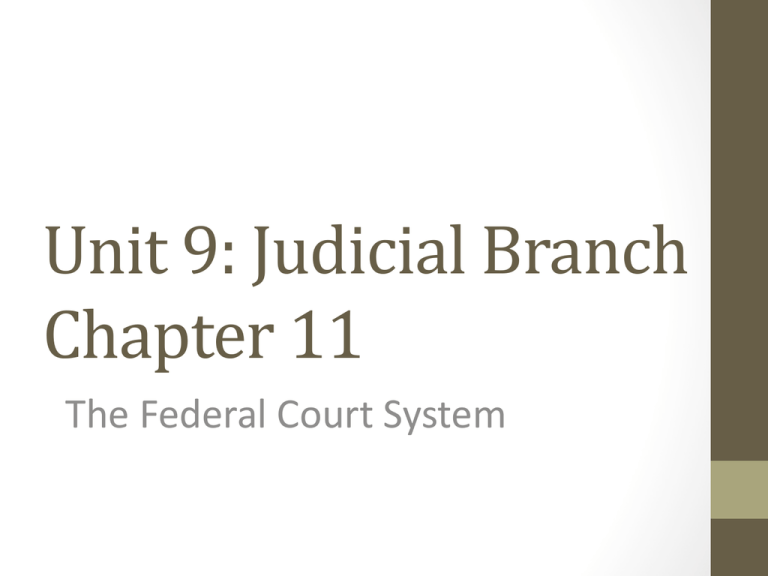
Unit 9: Judicial Branch Chapter 11 The Federal Court System Essential Question • Why is the Supreme Court an important part of our democratic system of government? I CAN: 1. Explain the Jurisdiction of the different courts 2. Analyze important Supreme Court Cases 3. Compare and Contrast the differences between a District Court and an Appellate Court 4. Evaluate the different ways why someone is choosing as a Federal Judge 5. List the 9 Supreme Court Justices 6. Describe the characteristics of a Supreme Court Justice Section 1: Powers of the Federal Courts Alexander Hamilton: Federalist 22 “Laws are a dead letter without courts to expound and define their true meaning and operation” Judicial System of the US • Is an adversarial system because the courts provide an arena for two parties to bring their conflict before an impartial arbiter (a judge) • Every case is a dispute between a plaintiff (someone pressing charges) and a defendant (charges being brought against) which are known as litigants, people engaged in a lawsuit. Two basic types of Cases 1) Criminal Law • An individual is charged with violating a specific law and provides punishment for that law • Felony (penalty over 1 year jail time) and Misdemeanor (less than 1 year jail time) • 98% heard in state and local level courts 2) Civil Law • Does not involve a charge of criminality; instead, it concerns a dispute between two parties and defines relationships between them • Examples: Divorce, Custody, Property, Contracts John Marshall • Played a minor role until Chief Justice John Marshall (18011835) and helped to increase the power of the Court. Article III, Section I “The judicial power of the United States shall be vested in one Supreme Court, and in such inferior courts as the Congress may from time to time ordain and establish.” Jurisdiction of the Courts • Federal Court system consists of Supreme Court and lower federal courts established by Congress • Each court has jurisdiction, or the authority to hear certain cases JURISDICTION Definition: • The authority or subject area that a court can hear a case about. • Example: Break a federal law, go to a federal court (robbing a bank). • Example: Break a state law, go to a state court (speeding). Powers of the Federal Court System Federal Courts cases: 1. 2. 3. 4. 5. 6. 7. 8. 9. 10. Federal Law Treaties with foreign nations Bankruptcy Admiralty or maritime law Foreign diplomats or foreign governments Two or more state governments The United States government Citizens of different states A state and a citizen of a different state Land grant claims of different states Supreme Court power: 1. Interpret the Constitution 2. Determine the constitutionality of state laws 3. Uphold regulatory laws 4. Protect civil liberties 5. Influence public policy Types of Jurisdiction 1) Exclusive - cases that can only be heard in Federal Courts. • Federal Crimes • Examples: cases involving ambassadors, bank robbery, kidnapping, presidential assassination, killing a police officer, destroying a mailbox-$1000 fine) • Examples: violations of patents and copyrights, cases involving ambassadors Types Of Jurisdiction, continued • 2) Concurrent– cases can be tried in either federal or state court. • A common type of concurrent jurisdiction: is “Diverse Citizenship” –dispute involving citizens of different states. • Federal District Courts may hear these if over $75,000 is involved. • Defendant can have the trial moved from the Plaintiff’s state to a federal district court. • Example: Land dispute between people from different states. Types of Jurisdiction, cont. 3) Original– court with the authority to be the 1st to hear a • case Usually found within District courts and are trial courts, where original jurisdiction takes place, trails are held, and juries may be impaneled. 4) Appellate– Review final decisions of district courts, court of appeals for lower court cases that have been lost • court where case is heard 2nd, 3rd, 4th, etc. (on appeal from lower court) Jurisdiction Of the Federal Courts – 1. U.S Supreme court has original and appellate 2. U.S Appeals courts have appellate 3. U.S District courts have original US Supreme Court 9 Justices D.C. Original and appellate Fewest cases 80-150/year US Court of Appeals 12 Courts (3 judge panel) Appellate US District Court 94 Courts (judge and 2 types of juries: 1. grand - indicts 2. petit - determines guilty or innocence) Original Most cases Developing and Extending Power and Due Process Clause IMPORTANT SUPREME COURT CASES 1) Marbury v. Madison 1803 • Created the concept of “judicial review” which allows the Supreme Court to declare the actions or Acts of Congress as unconstitutional • 9-0, Chief Justice John Marshall • Without this ruling, a Supreme Court and some say Checks and Balances do not exist… 2) Fletcher v. Peck 1810 • Continued to extend its power to review state laws • Law passed in Georgia legislature was a violation of the Constitution’s protection of contracts • Chief Justice John Marshall 3) McCulloch v. Maryland 1819 • McCulloch, head of the Baltimore Branch of the Second Bank of the United States, refused to pay the tax. State of Maryland argued that "the Constitution is silent on the subject of banks.” • Necessary and Proper Clause of the Constitution • Allowed the Federal government to pass laws not expressly provided for in the Constitution's list of express powers. Led to expansion of Fed. Gov’t. • Federal government v. States’ Rights • Chief Justice John Marshall [9-0] 4) Gibbons v. Ogden 1824 • Broadened the meaning of interstate commerce, further extending federal authority at the expense of the states • Chief Justice John Marshall 5) Dred Scott v. Sanford 1857 • Ruled Congress could not prohibit slavery in the United States territories and that enslaved African-Americans and their descendants were not U.S. Citizens. • Dred Scott traveled into a “free soil” state with his master. The issues for the Supreme Court were citizenship and property rights. • Chief Justice Roger Taney [7-2] • Impact• Civil War and Executive Order aka Emancipation Proclamation • Amendment 13- Outlawing slavery (1865) • Amendment 14- Rights of Citizens and Equal Protection (1868) Due Process Cases • Due Process Clausethat says that no state may deprive any person of life, liberty or property without due process of law, or proper constitutional procedures during a lawsuit and trial 6) Plessy v. Ferguson 1896 • Established the “separate but equal” doctrine making public segregation of Blacks and Whites legal. [8-1] • If facilities for both races were equal, they could be separate. • Impact• Legalized separation of everything • Schools, public buildings, hotels, etc. 7) Brown v. Board of Ed. 1954 • Established precedent that “separate but equal” doctrine of Plessy v. Ferguson (1896) was not equal. • NAACP case in Topeka, Kansas • Chief Justice Earl Warren [90] • Thurgood Marshall argued the case • Impact• Desegregation of all public schools and later public spaces • Civil Rights Movement • Bussing and Affirmative Action 8) Miranda v. Arizona 1966 • Ruled that police must inform you of your Constitutional Rights at the time of arrest. • Chief Justice Earl Warren [5-4] • Impact• “Miranda Law” --You have the right to…. 9) Roe v. Wade 1972 • Legalized the right of women to an abortion under certain circumstances. States were allowed to regulate in later trimesters. “Viability” is the determining factor. • Chief Justice Warren Burger [5-4] • Impact• Pro-Life • Pro-Choice • Mother’s rights v. Child/Fetus’ rights Section 2: Lower Federal Courts Constitutional Courts • Courts established by Congress under Article 3 are constitutional courts Federal District Courts • Created by Congress in 1789 to serve as trail courts • 94 district courts; with 646 judges • 2 Judges per district • Usually preside alone • Handle over 300,000 cases Examples: • Bank robbery • Mail fraud • Counterfeiting • Tax evasion • Bankruptcy • Civil rights Federal Court of Appeals • Created by Congress in 1891, 3 judge panel • Relieves the Supreme Court of burden of hearing all appeals • Currently 13 courts of appeals: 12 judicial circuits (regions) and 1 for national jurisdiction • 179 circuit judges, 55,000 cases a year • KY is 6st Circuit • Our district includes MI, OH, TN • May uphold, overrule, or modify the decision being appealed • No trail, no testimony of witnesses, panel of judges is looking for errors in procedure of law U.S. COURTS OF APPEALS D.C And Federal Circuit Make 13 Legislative Courts/Special Courts 1. US Court of Federal Claims (you suing the federal government) 2. Territorial Courts (land owned by U.S. like Guam) 3. Courts of the District of Columbia (court for people in D.C.) 4. US Tax Court (any violation of federal tax laws) 5. US Court of Appeals for Armed Forces (military has own set of laws, so they need their own court – appeals from JAG) 6. US Court of Appeals for Veterans Claims (if a veteran loses a service, this is where they appeal their case – like Agent Orange cases) 7. Court of International Trade- Civil cases arising out of tariff and other trade-related laws APPOINTING JUDGES Article II, Section II, Clause II – Supreme Court appointment process: Says that “the President shall nominate and by and with the advice and consent of the Senate shall appoint…Judges of the Supreme Court.” Appointing Judges, Continued 1. Party Affiliation- favor judges who belong to their political party 2. Judicial Philosophy- helps President to keep his ideology long after he is gone 3. Senatorial Courtesy– President asks the Senator (same party) from the state of the needed judge to recommend 3 candidates 4. Background- usually have had legal training and served as state court judges Section 3: The Supreme Court (SCOTUS) Supreme Court of the United States • Supreme Court is the ultimate court of appeals in the United States. • Usually a decision is determined by the rule of law or process..not the merit of the case. • They are the the final authority in any case involving the Constitution, acts of Congress, and treaties with other nations Supreme Court Cont. • Their power to hear a case is discretionary, no required to hear all cases • If the Supreme Court chooses to not hear a case, the lower court ruling stands. • If they chose to not hear a case, they do not have to give any rationale for why they have chosen not to hear the case…but sometimes they do. • Until 1891, justices spent much of their time riding the circuit, or traveling to hold court in their assigned regions of the country. Supreme Court Jurisdiction • Has both original and appellate jurisdiction • Article 3, Section 2 sets courts original jurisdiction and covers two types of cases: 1. Representation of foreign government 2. State is a party. Session • First Monday of October each year and usually continues in session through June. • Receives and disposes of approximately 5-9,000 cases a year. • A) Subject matter is not proper. • B) Subject matter is not sufficient to warrant a review of the full Court. • Cases are heard with all the Justices sitting together in open court. • Each year the Supreme Court hears about 150 cases of national importance and 3/4ths of such decisions are announced in full published opinions. TERM and SALARY For Constitutional Courts their term is LIFE • Until judge resigns, retires, or dies • Can be removed through impeachment (13 impeached, 7 of them removed) Salary is set by Congress and can not be decreased during their term in office. A Supreme Court Justice’s salary is same as U.S. Senators, Representatives, and the Vice President. Justices and their Duties • His/her main duty is hear and rule on cases 1.Deciding which cases to hear 2.Deciding the case itself 3.Determining an explanation for the decision, called the Court’s opinion U.S. Supreme Court Building • Located in back of the U.S. Capitol Building U.S. Supreme Court 2011-2012 • Nine Justices (1869): Eight Associate Justices led by a Chief Justice of the Supreme Court. John G. Roberts, Jr. • Chief Justice • Born in 1955 • J.D. Harvard Law • U.S. Court of Appeals for DC in 2003 (GWB) • George W. Bush nominated him C.J in 2005 [78-22] • Roman Catholic Antonin Scalia • Associate Justice • Born in 1936 • LL.B Harvard • U.S. Court of Appeals D.C. in 1982 (Reagan) • Ronald Reagan nominated him in 1986 [98-0] • Roman Catholic Anthony M. Kennedy • Associate Justice • Born in 1936 • LL.B Harvard • U.S. Court of Appeals 9th Circuit in 1975 (Ford) • Ronald Reagan nominated him in 1988 [97-0] • Roman Catholic Clarence Thomas • Associate Justice • Born in 1948 • J.D. Yale • U.S. Court of Appeals D.C. in 1980 (GHWB) • George H.W. Bush nominated him in 1991 [52-48] • Roman Catholic Ruth Bader Ginsburg • Associate Justice • Born in 1933 • LL.B Columbia • U.S. Court of Appeals D.C. in 1980 (Carter) • Bill Clinton nominated her in 1993 [96-3] • Jewish Steven G. Breyer • Associate Justice • Born in 1938 • LL.B. Harvard • U.S. Court of Appeals D.C. in 1980 (Carter) • Bill Clinton nominated him in 1994 [87-9] • Jewish Samuel A. Alito, Jr. • Associate Justice • Born in 1950 • J.D. Yale • U.S. Court of Appeals 3rd Circuit in 1990 (GHWB) • George W. Bush nominated in 2006 [58-42] • Roman Catholic Sonia Sotomayor • Associate Justice • Born in 1954 • J.D. Yale • U.S Court of Appeals 2nd Circuit in 1998 (Clinton) • Barack Obama nominated her in 2009 [68-31] • Roman Catholic Elena Kagan • Associate Justice • Born in 1960 • J.D. Harvard • U.S. Court of Appeals (expired) • Solicitor General represents U.S. Government • Obama nominated her in 2010 [63-37] • Jewish Politics of Judicial Selection • Appointments influenced by: 1.Political ideology / Partisanship 2.Interest groups 3.Other Justices 4.Senators 5.American Bar Association (ABA)- largest national organization of attorney’s • Has been consulted by every president concerning federal nominations • Committee rates as either, “well qualified,” “qualified,” or “not qualified.” Works Cited Page • Chapter 11: Federal Court System PowerPoint • Chapter 12: SCOTUS • Chapter 12: Landmark Court Cases
